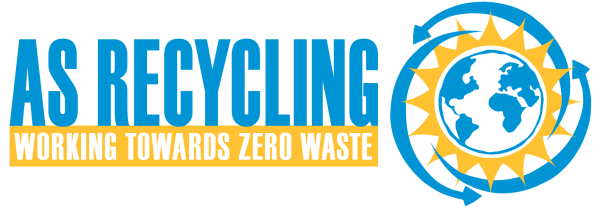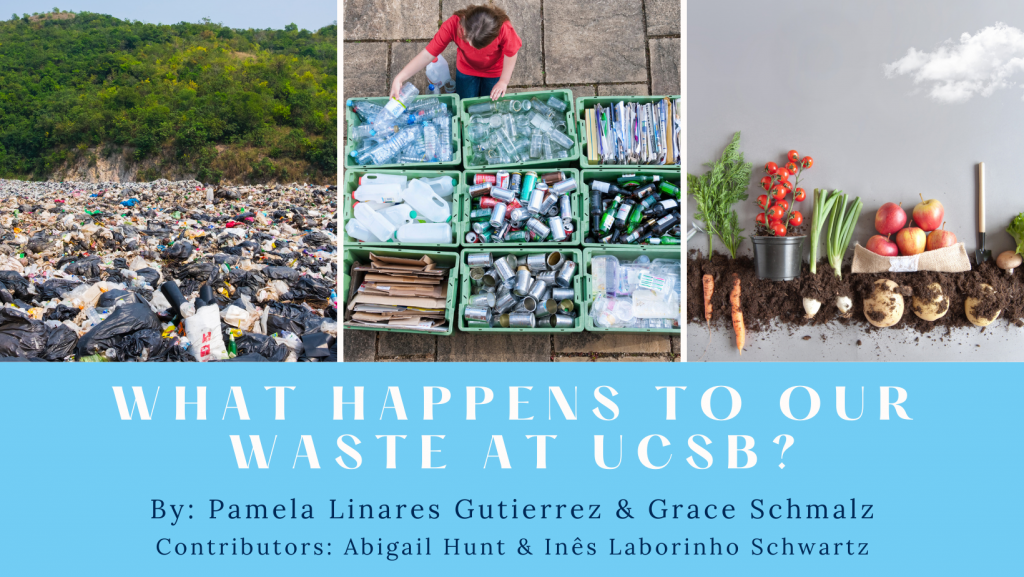The Waste Journey
How often do you throw away your granola bar wrapper or banana peel and wonder where it is heading next on its journey? We might not often consider where our waste goes after we throw it away, but when we put our trash in the bin, the waste journey is far from over.
UCSB has a comprehensive and extensive waste management system with some actors you may be familiar with such as AS Recycling (ASR), the Department of Public Worms (DPW), and Facilities Management (FM). ASR and DPW are dedicated to helping the University of California reach its zero waste goals. To find out more information about the UC’s goals, check out this website.
The organizations and goals may be familiar to you, but did you know that we have a waste hauler, MarBorg Industries, or that our landfill waste travels to a landfill in Santa Barbara? Waste management at UCSB is more complex and extensive than many people realize. Read on to find out where our recycling, compost, e-waste, and landfill waste go after they complete their time at UCSB.
Where does our recycling waste go?
UCSB’s robust recycling program allows our campus community to reduce the amount of waste traveling to a landfill, as well as the amount of new materials that need to be produced and/or harvested.
The recycling journey begins with you when you place your recyclable items in the proper bin. For a detailed list of what is currently recyclable on campus, please visit our Recycling page. For a more in depth description of all the recycling services we provide on campus, please visit our Campus Resources page.
Once you place your waste in the proper bin, Route Riders will collect and sort this waste and then dispose of it in the proper dumpster. This waste will then be transported by our waste hauler, MarBorg Industries. It will be taken to the Goleta Transfer Station where it is further sorted. At this site, the only thing that is recycled is green waste (grass clippings, shrub and yard clippings, branches, etc.) All other recycling is sold to various recyclers to continue its journey elsewhere. Recycling at UCSB and around the world is heavily dependent on the international commodity markets. There has to be a demand for certain recycled materials which is why the list of items that are recyclable can sometimes change.





Where does our compost go?
Composting, which turns organic waste into a soil amendment to help plant growth and development, also has an important presence on campus. You can find compost bins both indoors and outdoors on campus. For a detailed description of what compost is, what can be composted, and where to find some bins, feel free to check out our Composting page!
The compost journey begins with you when you place your compostable item into the proper bin. Route Riders then collect and sort this waste in compostable trash bags. These are then placed into compost dumpsters which are serviced by MarBorg Industries. MarBorg Industries transports our compostable waste to Engel & Gray, an industrial compost facility in Santa Maria.
Engel & Gray transforms our compostable waste into a soil amendment called a Harvest Blend. They transform our waste through a process known as the “aerobic windrow method.” The Harvest Blend is then sent to a laboratory for a safety and quality check and, once approved, is distributed widely across Santa Barbara County and UCSB as a soil amendment for landscaping.





Where does our e-waste go?
Our electronic waste goes on its own unique journey as well. After an e-waste item is placed in the proper bin, Route Riders pick up all e-waste on designated routes exclusively designed for picking up e-waste. E-waste tends to be pretty heavy, so Route Riders trade in their bikes for an electric vehicle to help transport the waste. Once collected on campus, e-waste is taken to Distribution & Logistical Services (DLS). The e-waste is weighed, sorted, and then, if in good condition, DLS can refurbish and sell in-house at Surplus Sales. Anything that is not sold there goes to Electronic Recyclers International.
ERI is an E-Steward certified recycler based in Fresno. They transform e-waste into a commodity that is recycled and then reintroduced into new products, allowing these materials to continue being useful for a while longer.




Where does our landfill waste go?
Unfortunately, a portion of the waste produced at UCSB will have to end up in a landfill. Route Riders and Facilities Management work together to pick up and throw landfill waste away in the proper dumpster. This waste does not get sorted which is why it is important that you, as a member of our community, sort your waste properly when you throw things away. If you accidentally place a compostable or recyclable item in the landfill bin, it will unfortunately not be sorted. This waste will travel directly to the landfill even if it could have continued its journey elsewhere.
Landfill waste is taken by our waste hauler, MarBorg, to the Tajiguas landfill in Santa Barbara. This landfill serves the South Coast and the Santa Ynez and New Cuyama Valleys and can process up to 1,500 tons of trash per day.




The Common Denominator
You may have noticed that the Waste Journey, regardless of what type of waste it is, always begins the same way; with you. Your choices as a consumer influence how much waste will end up in the Tajiguas landfill, how much will be composted, and how much will be recycled. It’s also important that you, as a member of our campus community, take special care to sort your waste properly so that we can ensure that all of our waste at UCSB ends up in the right place.
The Waste Journey shows us that trash does not simply disappear once we throw it away. It has a life long after we forget about it, and it’s important to consider where it will end up after we throw it out so that we can better understand our impact on waste and the environment.
Want to learn more?
Below are some of the sources we utilized and links to some of the organizations/facilities we mentioned in the article;
- Compost Facility; http://www.engelandgray.com/
- Recycling Transfer Station; https://www.countyofsb.org/pwd/southcoast.sbc
- Tajiguas Landfill; https://www.countyofsb.org/pwd/tajiguaslandfill.sbc
- Electronics Recycling International; https://eridirect.com/services/electronics-recycling-ewaste/
- Zero Waste Policy; https://www.ucop.edu/sustainability/policy-areas/waste-reduction-and-recycling/index.html

